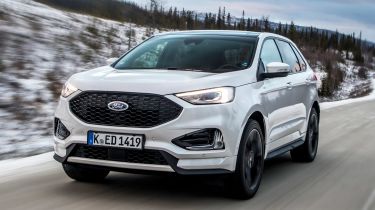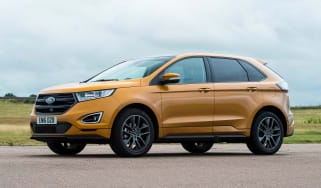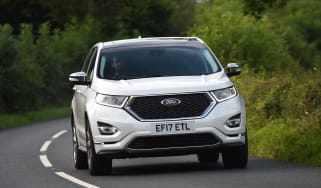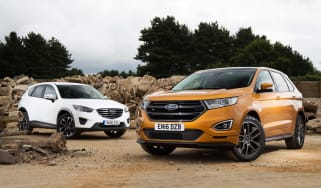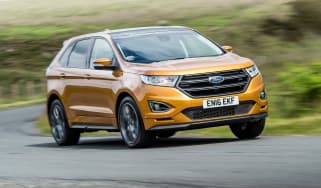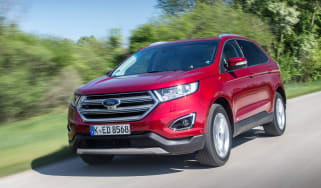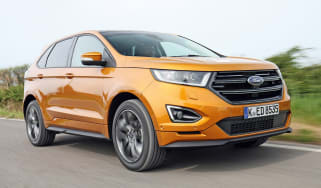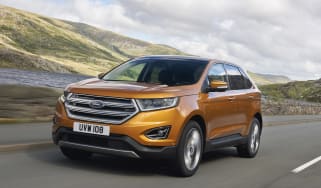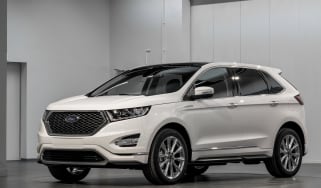Ford Edge (2016-2019) review
The Ford Edge has plenty of space and technology, but it's only a five-seater

The Ford Edge is a family-sized SUV with an impressively practical interior lurking within its substantial dimensions. It’s comfortable, easy to drive, very well equipped and comes with a good collection of safety aids to help give you added peace of mind.
Ford is hoping to make a step upmarket with this car, however, and the dull handling might hold the Edge back when it’s compared to rivals in its price bracket. There’s no seven-seat option, while many buyers might wince at paying so much for a Ford, especially as the top models now cost in excess of £40k.
Tough competition in the large SUV class means the Ford Edge has a fight on its hands. It's the biggest SUV that Ford has for sale in the UK, and there's plenty of space on board, which makes it ideal for families, although there's no option of seven seats.
That's a shame, because many rivals to the Edge have seven seats as standard or as an option. Those rivals include the Skoda Kodiaq, Peugeot 5008, SEAT Tarraco, Kia Sorento, Hyundai Santa Fe and even the Land Rover Discovery Sport. You may possibly consider a Ford Edge over basic five-seat versions of the BMW X3 and Mercedes GLC, and this also gives you some idea about where the Edge is priced, starting from around £37,000.
Used - available now

2024 BMW
i4
32,227 milesAutomaticElectric
Cash £31,491
2023 Hyundai
i10
20,826 milesAutomaticPetrol1.2L
Cash £11,781
2023 Audi
e-tron Sportback
16,403 milesAutomaticElectric
Cash £23,822
2025 Toyota
Yaris Hybrid
15,484 milesAutomaticPetrol1.5L
Cash £14,990An update for the 2019 model year sees the range simplified, but all cars are well equipped. There's no Zetec model offered, so the plush Edge Titanium is the 'entry level' model, sport-focused ST-Line and luxury Vignale trims offered, and all models are loaded with kit, including a powered tailgate, privacy glass, heated electric leather seats, reversing camera and front and rear parking sensors, auto LED headlights, climate control and keyless entry.
As you would expect, ST-Line adds a sportier look, with 20-inch wheels and sports suspension, while Vignale models also add bigger wheels, extra colour coded bodywork and plush front seats with extra padding.
Changes under the skin include the addition of Ford's latest EcoBlue four-cylinder diesel engine. This comes in two power outputs - 148bhp or 235bhp – both of which use a six-speed automatic gearbox, while the lower powered engine is front-wheel drive, and the larger one is 4WD. Which engine you choose determines the trim you go for, and vice-versa, because the Titanium comes with the 148bhp engine, while the ST-Line and Vignale models exclusively use the more powerful motor.
Choose either engine, and quoted economy is poorer than the pre-facelift Edge. However, that's because of the new WLTP testing procedure than any drop in efficiency. Claimed economy for the 2.0 EcoBlue 150PS is up to 42mpg, while the four-wheel drive-equipped 238PS engine has a best of 41.5mpg. That's not as good as some large SUV rivals, though.
Prices for the Ford Edge start from around £37,000 for the 2.0 EcoBlue 150PS Titanium, while the more powerful ST-Line is around £43,000 and the Vignale is £46,000.
Engines, performance and drive
Ford makes it clear that the Edge is targeted at premium buyers, and the driving experience reflects that. It goes about its business in a relaxed and refined manner, but there’s little of the involvement you would find in a BMW X3.
The Edge is one of the largest mainstream SUVs on the market, and you really feel that on tight country lanes or in town. With a width of nearly 2.2-metres including mirrors it’s difficult to thread through traffic, and visibility isn’t great either.
Titanium and Vignale models get a more comfort-biased suspension setup than ST-Line models, which receive firmer springs, bigger wheels and an adaptive steering system. The ride on the former is impressively smooth and soft around town, absorbing potholes and ruts with ease.
ST-Line brings a noticeably firmer ‘edge’ to the ride around town as the 20-inch alloys pick up bigger imperfections, but it's no worse than an S-Line Audi Q5. ST-Line and Vignale versions of the Edge are competent enough off-road thanks to the four-wheel drive system and decent ground clearance.
The downside to the Edge’s chassis is found in the bends. Models without sports suspension can pitch and wallow when you up the pace, and the remote, elastic feel to the steering means you never really get the impression you’re part of the driving experience. A number of rivals are better in this regard - and even the ST-Line model doesn't feel particularly sporty.
ST-Line versions get a variable ratio steering system that reduces the amount of steering input needed at slow speeds and when parking, but then is supposed to make the Ford Edge more stable at high speeds. It does aid low speed manoeuvres to an extent, but even in the weightier Sport mode it feels much the same as the standard rack at higher speed. It’s an option on lesser models, and not one we’d bother with. Body control is improved a bit thanks to the stiffer springs, but it’s a long way from offering the sharpness of a Mazda CX-5 or BMW X3.
Ford has added its Active Noise Control system from the Mondeo Vignale to the Edge. It uses sound waves to cancel out the frequency of road noise and diesel clatter, and seems to work well. It’s standard across the range, too, and helps the Edge to be one of the quietest and most refined cars in any class - when we tested the Edge, we recorded an interior noise figure at 70mph that was on a par with the Bentley Bentayga.
Engines
The Edge is also sold in the US, and over there you can choose from a range of four and six-cylinder petrol engines. Ford has decided that none of those engines are appropriate for Europe, and the diesel range was updated in 2018.
All cars get Ford's latest 2.0 EcoBlue four-cylinder diesel, and there are two versions, 150PS and 238PS with 148bhp and 235bhp respectively.
Performance is more adequate than urgent. In the 148bhp model, 0-62mph takes 11.2 seconds, which isn't that impressive and largely down to the response of the standard-fit auto gearbox. It takes a while to build up speed, and overtaking means kicking down a few gears. For cruising and family use it’s reasonable, but keen drivers should look elsewhere.
The more powerful diesel isn’t much quicker on paper, thanks to the addition of the heavy four-wheel-drive system. It manages 0-62mph in 9.6 seconds. It feels a bit more punchy in gear, but progress is hampered by the slightly lethargic six-speed automatic gearbox. BMW or Audi’s dual-clutch systems are much more responsive, and it all adds up to performance that never really matches the ST-Line's sporty pretentions. Still, the payoff is a decent level of refinement and smooth changes when you’re not in the mood, which is in-keeping with the Vignale model's upmarket aspirations.
MPG, CO2 and Running Costs
Ford will tell you that the Edge aims to appeal to a more affluent customer than something like a Renault Kadjar, and the price mirrors that ambition. It starts from around £37,000 for the less powerful diesel in Titanium trim (it's not available with any other trim level), while the ST-Line and Vignale are around £43,000 and £46,000 respectively.
However, those list prices also mean that the ST-Line and Vignale versions of the Edge are hit by the Government's £310 road tax levy for the first five years of ownership, so these two cost £450 a year compared to £140 road tax for the Titanium model.
And that's not the end of the high running costs. While Ford offered a six-speed manual in the past, the whole range now gets a conventional torque convertor six-speed automatic. The front-wheel drive, 148bhp EcoBlue model has claimed WLTP fuel economy of 42.4mpg on 19-inch wheels (adding 20-inch wheels reduces this further), while the 235bhp has claimed economy of 41.5mpg on 20-inch wheels. The WLTP test structure is designed to simulate a more realistic driving experience, so you might get closer to these figures than you would with the better quoted figures when the Edge first arrived in the UK. At least the 66-litre fuel tank means you can travel a fair distance between fills, though.
In line with these fuel figures, the Edge’s emissions are 153g/km for the 150PS engine, and 176g/km for the 238PS engine. The best figures are for the front-wheel-drive model, but the auto box still makes its presence felt, so the Edge has relatively ordinary figures when compared to low-emitting models such as the Peugeot 5008 and Skoda Kodiaq.
Insurance Groups
The cheapest Edge sits in insurance group 26, while the top models are in groups 34 and 37. That’s a reasonable rating, which is only slightly more than mainstream SUVs like the Honda CR-V, and on a par with most premium rivals like the Audi Q5 and Mercedes GLC.
Depreciation
Traditionally, larger, more expensive SUVs with mainstream badges struggle to hold onto their value in the used market, but the Ford Edge isn't too bad. It ranges from 43-47 per cent after 3 years/36,000 miles.
To get an accurate valuation on a specific model check out our free car valuation tool...
Interior, design and technology
Over time, the rest of Ford's range has been given a makeover to look similar to the Edge. Park its biggest SUV next to the mid-sized Kuga and diddy EcoSport, and the family resemblance will be obvious.
Around the back, the one-piece tail light bar from the original Edge has been ditched for the 2019 model year, but the steeply raked rear window and high shoulderlines are still present to give the Edge a premium look. Even base models are highly specced, so 19-inch alloys are standard, while 20-inch wheels are available as an option. The Edge Vignale gets chromed 20-inch alloys and a sparkly grille, plus Vignale badges on the tailgate.
ST-Line models get gloss black detailing and 20-inch wheels. And while the original ‘Electric Spice’ orange paint is no longer offered, there is bright red paint offered, although the rest of the colour palette is rather restrained. We take issue with the fake exhaust tips, however, as Ford hasn’t gone to much trouble to hide the rear items underneath. LED headlights are standard on all cars, with top-spec versions getting matrix LEDs.
Inside, the dash layout will be familiar to anyone who’d driven an S-MAX or Galaxy. It’s almost identical, with the same curved centre console built from rather cheap-feeling plastic. The design is a bit plain when compared to the classy Mercedes GLC, but at least there’s plenty of soft-touch trim on the doors and dash top. The Vignale model is expensive, but only adds a little leather and isn't enough to justify its cost. The digital instruments are smart and clear, too, although there’s an overload of information and settings that can prove confusing.
Safety tech such as Lane Keep Assist, Active City Stop and Traffic Sign Recognition is also standard, which is stuff that you’ll often pay extra for on German rivals. Titanium models feature sat-nav, acoustic glass, chrome roof rails and an electric bootlid, plus heated front seats trimmed in leather. However, only the driver's seat has electric adjustment. Move up to an ST-Line or Vignale, and you get heating and cooling functions.
Sat-nav, stereo and infotainment
Go for the Edge Titanium and you get Ford's SYNC 3 eight-inch touchscreen with sat-nav, DAB radio, Apple CarPlay and Android Auto, which is the same as you’ll find in the Mondeo and S-MAX. The graphics are bright and clear and its feature-packed.
ST-Line and Vignale models add a 12-speaker Bang & Olufsen sound system to this, while all cars feature 2 USB sockets for connecting and charging devices.
Practicality, comfort and boot space
The big benefit of the Edge’s substantial exterior size can be found inside. As well as plenty of space for those up front, rear legroom is substantial and enough to ensure five adults can sit in comfort. It’s even better than already spacious cars like the Honda CR-V, and beats the BMW X3 for rear seat accommodation.
Combine that with one of the biggest boots in the midsize SUV class and you’ve got a useful large family car for the school run. It’s a shame, then, that Ford has elected not to offer a seven-seat version here for now, claiming the S-MAX and Galaxy cater for that market. At least storage in the cabin is good, with a sizeable glovebox, central cupholders and chunky door bins, plus a cubbyhole on top of the dashboard.
Dimensions and size
The Edge is a sizeable SUV, which is unsurprising given that it is designed to cater for American needs. Whereas a Nissan Qashqai is 4.4m long, and a Honda CR-V is around 4.6m long, the Edge is a full 4.8m long. That makes it bigger than the Audi Q5, Mercedes GLC and BMW X3, and it's even fractionally bigger than a VW Touraeg. It’s also nearly 2.2m wide including wing mirrors, which is an issue around crowded city streets.
Legroom, headroom and passenger space
Given its exterior dimensions, the Ford Edge delivers about what you’d expect in terms of accommodation. The front seats are comfortable and highly adjustable, while in the back there’s plenty of legroom and good head and shoulder room for three adults sitting side by side. However if you opt for a model with the panoramic sunroof, it eats into headroom considerably. It’s not a deal breaker, but it cuts down on the spacious feel when the sun shade is in place.
Given how much legroom there is in the second row, we can’t help but feel that Ford could easily offer a seven-seat variant here. Chinese buyers get the choice, but we don’t.
Boot space
One of the biggest selling points of the Ford Edge is its large boot. At 602-litres with the seats up, its bigger than anything BMW, Audi or Mercedes can manage, while even the Honda CR-V is smaller at 589 litres. Fold the seats down (which you can do electrically via buttons in the boot) and you get a full 1,847-litres of space. There’s a space-saver spare wheel, too, although underfloor storage compartments are small.
Towing
The Ford Edge is a capable towing car, and irrespective of which model you go for its maximum braked trailer towing capacity is 2,200kg.
Reliability and Safety
Ford sells some of the most popular cars in the UK but its rankings in our Driver Power satisfaction survey are fairly average. In the 2018 results, the brand finished 16th out of 26 manufacturers, but that said, Ford has moved up the tables in both our 2016 and 2017 results.
Customers had gripes with Ford’s in-car tech and as the Edge uses the same system as you’ll find in the Focus and Mondeo, we can expect similar complaints here. Buyers have also raised concerns with poor reliability and build quality, too.
As the Edge is an all-new model, the car itself hasn’t yet made it into the Driver Power survey. However, the Ford Kuga – the Edge’s smaller brother – did rank as the 32nd best car to own out of 75 in the 2018 survey.
The Edge does come laden with safety tech, such as road sign recognition, adaptive lighting, adaptive cruise control, Intelligent speed assist and cross traffic alert.
Warranty
As with every new Ford, the Edge comes with a three-year warranty. The first year is with unlimited mileage while the second and third years will covers owners up to 60,000 miles. Customers also have the option to extend the warranty for an additional 12 or 24 months. But that will only just match the Hyundai Santa Fe's warranty cover, and is still two years short of the Kia Sorento.
Servicing
Ford has a huge amount of servicing centres across the UK, but to spread the costs of servicing Ford does offer fixed priced servicing plans which can be paid for monthly.

